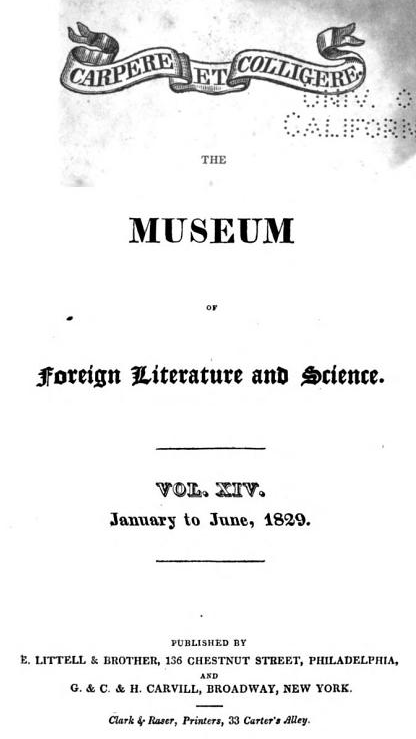From the Monthly Review.
LETTERS FROM THE WEST: containing Sketches of Scenery, Manners, and Customs; and Anecdotes connected with the First Settlement of the Western Sections of the United States. By the Hon. Judge Hall. 8vo. pp. 385. London. Colburn. 1828.
Our author commences his tour at Pittsburgh, formerly the ultima Thule of travellers, but now the vestibule through which they approach the great states of the West. It is favourably situated at the head of the Ohio, and the confluence of the Monongahela and Allegheny rivers. The scenery around the town is charming. A circle of hills encloses it, from various points of which the three rivers just mentioned may be seen winding through the country.
“The city lay beneath me, enveloped in smoke—the clang of hammers resounded from its numerous manufactories—the rattling of carriages and the hum of men were beard from its streets—churches, courts, hotels, and markets, and all the ‘pomp and circumstance’ of busy life were presented in one panoramic view. Behind me were all the silent, soft attractions of rural sweetness—the ground rising gradually for a considerable distance, and exhibiting country seats, surrounded with cultivated fields, gardens, and orchards. On either hand were the rivers, one dashing over beds of rock, the other sluggishly meandering among the hills; while the lofty eminences beyond them, covered with timber, displayed a rich foliage, decked and shadowed with every tint of the rainbow. Below the town, the Ohio is seen, receiving her tributary streams, and bearing off to the west, burthened with rich freights. The towns of Allegheny on the right hand, and Birmingham on the left—the noble bridges that lead to the city in opposite directions—the arsenal, and the little village of Laurenceville, in the rear, added variety to the scene.”—pp. 22, 23.
The smoke of Leeds or Manchester is a pure atmosphere, compared with the masses of soot sent forth by the Pittsburgh coal. Even the snow that falls there is said to be tinged with it! The principal manufactures of this town consist of iron and glass ware. It is the principal place of deposit for goods destined for the western country. It is moreover a port of entry, a distinction which seems to have occasionally puzzled the Italian custom-house officers, if we are to believe an anecdote related by Mr. Clay, on the floor of Congress:—
“‘To illustrate the commercial habits and enterprise of the American people, (he said) he would relate an anecdote of a vessel, built, and cleared out at Pittsburgh for Leghorn. When she arrived at her place of destination, the master presented his papers to the customhouse officer, who would not credit them, and said to him, “Sir, your papers are forged; there is not such a port as Pittsburgh in the world; your vessel must be confiscated.” The trembling captain laid before the officer the map of the United States—directing him to the gulf of Mexico—pointed out the mouth of the Mississippi—led him a thousand miles up it to the mouth of the Ohio, and thence another thousand up to Pittsburgh. “There, Sir, is the port whence my vessel cleared out.” The astonished officer, before he had seen the map would as readily have believed that this vessel had been navigated from the moon.’”—pp. 36,37.
——Museum of Foreign Literature and Science, April, 1829, quoting from the Monthly Review. From the description, we can tell that the writer stood on the Hill, which was then not much settled, and looked westward.


0 responses to “An English View of Pittsburgh in the 1820s”
I read, several years ago, that Pittsburgh was the largest inland port in the US. Is this still true?